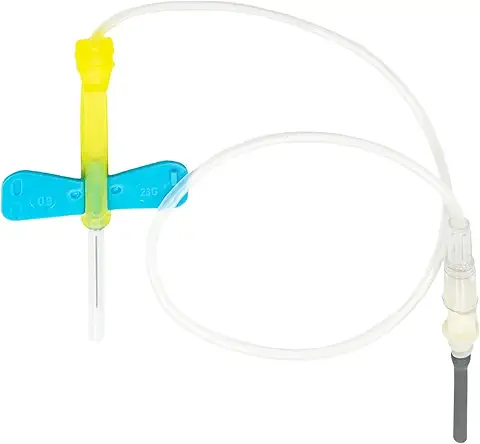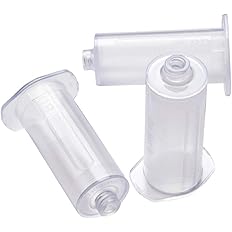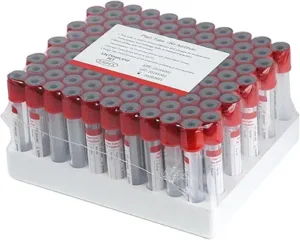A needle is a slender, sharp, and hollow medical instrument typically used to inject fluids, draw blood, or administer vaccines and other medications. It consists of a thin, sharp metal shaft with a pointed tip at one end and a hollow bore through which substances are injected or withdrawn. Needles are commonly used in conjunction with syringes to perform various medical procedures.
Key Features of Needles:
-
Needle Tip: The pointed end of the needle designed to penetrate the skin or other tissue easily.
- Bevel: The slanted edge of the needle’s tip, which helps make insertion smoother.
- Cutting or Non-Cutting Tips: Some needles have a beveled edge designed for smooth puncture (non-cutting), while others are made for more precise incisions.
-
Needle Shaft: The hollow portion of the needle that is typically made from stainless steel. It’s where the medication, fluid, or blood passes through.
-
Needle Hub: The part of the needle that connects to the syringe. This is where the needle is fixed onto the syringe or catheter.
-
Needle Gauge: Refers to the thickness (diameter) of the needle. A higher gauge number means a thinner needle, while a lower gauge number indicates a thicker needle. Common needle gauges range from 18G (thick) to 30G (thin).
- Larger gauge (thicker needles) are often used for thicker fluids (e.g., blood draws, intravenous fluids).
- Smaller gauge (thinner needles) are used for injections that require more precision and less discomfort (e.g., vaccines, insulin).
-
Needle Length: The length of the needle varies depending on the type of injection or procedure. Common lengths range from 3/8 inch to 1.5 inches (1 cm to 4 cm).
- Shorter needles are typically used for subcutaneous (under the skin) injections.
- Longer needles are used for intramuscular (in the muscle) or intravenous (in the vein) injections.
Types of Needles:
-
Hypodermic Needles:
- Used for injections into the skin, muscle, or veins.
- They can be used with a syringe for drawing and injecting fluids like medication or vaccines.
-
Insulin Needles:
- Specifically designed for diabetics to administer insulin subcutaneously.
- These are usually smaller in diameter and length for comfort and ease of use.
-
Syringe Needles:
- These needles are attached to syringes and are used for various medical procedures like drawing blood or injecting fluids into the body.
- The syringe is typically marked with measurements to allow for precise dosage.
-
Intravenous (IV) Needles:
- Used to insert into veins for intravenous fluid administration, medication, or blood draws.
- They often come with a catheter that stays in the vein once inserted, allowing for continuous access.
-
Spinal Needles:
- Used in procedures like spinal taps (lumbar puncture) for collecting cerebrospinal fluid or administering anesthesia.
- These are long and designed to penetrate deep tissue.
-
Epidural Needles:
- Designed for administering epidural anesthesia, typically during childbirth or surgery.
- They are longer and wider than typical needles to reach the epidural space around the spinal cord.
-
Blood Collection Needles:
- Used in drawing blood from a vein (venipuncture) for tests or donation.
- These needles may be either straight or butterfly-shaped, with the latter being more flexible for use in smaller veins or in children.
Uses of Needles:
- Injections: Administering vaccines, insulin, medications, or local anesthetics into the body.
- Blood Draws: Extracting blood for lab tests, blood donations, or transfusions.
- Intravenous (IV) Access: For fluid administration or delivering medications directly into the bloodstream.
- Biopsy: Used to remove a small sample of tissue for diagnostic testing.
- Vaccinations: Injecting vaccines to prevent diseases like flu, hepatitis, etc.
- Anesthesia: Administering local or general anesthetics before surgery or medical procedures.
Common Injection Types:
- Intramuscular (IM): Injected into the muscle. IM needles are typically longer to reach deeper muscle layers.
- Subcutaneous (SubQ): Injected just under the skin. These needles are shorter and used for medications like insulin.
- Intravenous (IV): Injected directly into the vein. These needles are typically used for fluids, blood draws, or administering medications.
- Intradermal (ID): Injected just below the surface of the skin. Common for allergy testing and tuberculosis tests.
Needle Safety:
- Needle Stick Injuries: Healthcare professionals must take precautions to avoid needle stick injuries, which can lead to the transmission of bloodborne diseases like HIV and Hepatitis B and C.
- Safety Needles: Many modern needles come with safety features, such as retractable needles or shields that prevent accidental needlesticks.
- Sharps Disposal: Used needles must be disposed of properly in sharps containers to prevent injury or infection.




Reviews
There are no reviews yet.